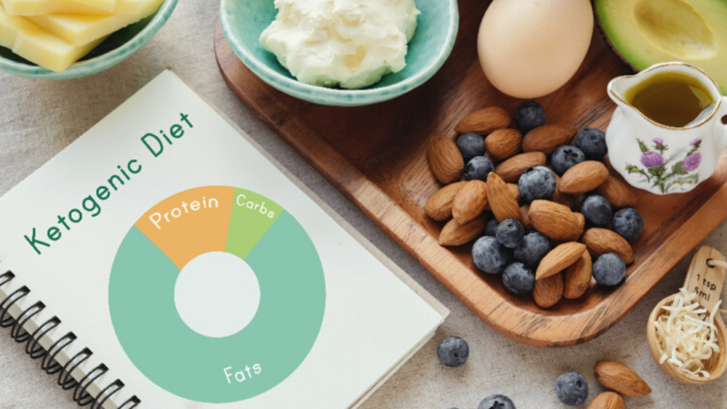National Keto Day
National Keto Day
Happy National Keto Day! This day of recognition is right at the start of the New Year—making it a great time learn the ins-and-outs of the keto diet and kick-start your healthy New Year’s resolutions. With this blog, we will explain:
- What ketosis actually is
- The effects of ketosis
- What the ketogenic diet consists of
- How to know if you are in a ketogenic state
- Is ketosis is right for you
What is ketosis?
So what is this fancy word ketosis, you ask? Ketosis is the state in which the body uses fat as its main energy source instead of carbohydrates (sugars). It does this by relying on the use of blood ketones, an alternative fuel source to glucose that utilizes fat instead of sugar, to deliver energy to the cells throughout the body.
How do I get into a ketogenic state?
In order to push your body into a ketogenic state, you must begin to produce blood ketones—the machinery necessary for our body to begin converting fat into energy. Since our bodies have been long adapted to the typical western diet that is high in inflammatory carbohydrates, it can be an uncomfortable process to make the switch to burning fat.
What you will need to do is choke your supply of carbohydrates, and increase the intake amount of healthy dietary fat. Once your body has burned through all the calories it can find via carbohydrates, it will be forced to make the switch. This conversion to the use of fat for energy will take time as your body will first need to build the ketone bodies necessary to process fat.
Think of the conversion from carbs to dietary fat like how a household that has been running on oil and coal for decades converts to clean renewable energy; it’s not going to happen instantly as those solar panels still need to be built and installed.
What are the effects of ketosis?
There are several beneficial effects of being in a ketogenic state.
Weight loss. By forcing your body to begin burning fat for energy, you will begin to lose body fat. This is because when you burn through your dietary fat, your body can keep chugging along and begin to burn through your stored fat. This is different from when your body would burn through your dietary carbohydrates, but instead of burning through your stored fats, you would instead feel hunger and cravings as your body does not have to tools necessary to convert your stored fats into energy.
The ‘Keto High’. Once in a ketogenic state, many people find that their mental state and function has improved. Some have also noticed a decrease in symptoms of depression and an increase in memory function. Studies have attributed this to BHB’s (beta-hydroxybutyrate, a ketone body) ability to improve the efficient use of oxygen and increase hydraulic function, as well as the fact that a gram of fat provides 9 calories, which is over twice the amount that can be attained through carbohydrates (4 calories).
Lowered Insulin. Those with high insulin have insulin resistance as a result of high blood sugars from a high consumption of carbohydrates, which is a red flag for prediabetes and type 2 diabetes. The ketogenic diet combats this perfectly. By reducing the carb intake and relying on a different energy source for food, your body will have time to recover from the chronic inflammation and stress that comes from high blood sugar. As your blood sugar lowers, so will your insulin levels.
Treatment of Illness. Ketosis has been looked at in studies for treating diseases such as epilepsy, ALS, Alzheimer’s, Parkinson’s, and even some cancers. It found that some cancers feed off of carbohydrates, and by restricting your body’s supply of carbs and switching to fat, you effectively starve the cancer, while you feast on a healthy fuel source.
Lack of Hunger/ Cravings. As your body has switched to a more efficient fuel source and is receiving more calories per gram of food, you will find that your cravings and hunger pains have disappeared. This is because your body is also now easily able to burn through your stored fat reserves once it burns through your dietary fat, as it now has ketone bodies, and thus the machinery needed to process fat.
What does a ketogenic diet consist of?
A ketogenic diet requires that you receive most of your dietary calories from fat and that you restrict your carbohydrate intake. 75% fat, 20% protein, and 5% of calories from carbohydrates are the numbers suggested by most keto enthusiasts.
To help visualize this, it means that about half of a meal plate is covered in vegetables/ greens, a quarter protein, and a quarter fat. This is because fat provides 9 calories per gram, and thus does not need to be taken in great quantities, as it still provides more than enough calories to meet the 75% quota.
To keep things simple, most keto dieters keep their total carb intake less than 50g per day. It is also important not to consume too much protein, as your body may convert the protein into sugar, which will serve as another obstacle to achieving ketosis.
Here is a short list of some good foods to eat while on a ketogenic diet. They are either high in fat or low in carbohydrates and they all have plenty of nutrients.
- Kale
- Spinach
- Avocados
- Hummus
- Eggs
- Tempeh
- Tofu
- Unsweetened yogurt
- Olive oil
- Butter
- Cheese
- Cream
- Peanut/ Almond Butter
- Macadamia Nuts
- Almonds
- Pecans
- Chia Seeds
- Coconut butter
- Beef
- Bacon
In addition, be sure to avoid these foods:
- Grains
- Bread
- Rice
- Potatoes
- Added Sugar
- Baked Goods
- Ice cream
- Dried Fruit
- Alcohol
- Candy
- Soda
- Juice
How do I know if I am in ketosis?
In order to gauge whether or not you are in ketosis, it is important to pay attention to a few things.
Ketone Levels. An easy way to measure your body’s ketogenic state is by checking its production of ketone bodies. Initially, this can easily be measured via ketone strips that use your urine to check if you are urinating ketones. However, after you have been in a ketogenic state for a few weeks, this method will stop working, as your body has now adapted to ketosis and will no longer continue to urinate excess ketones. At this point, it will be necessary to check your blood ketone levels with a ketone meter that uses a sample of your blood to determine this.
No cravings. Once you’ve gotten into a ketogenic state, you’ll find that you have zero cravings, as your body now has all the calories and nutrients it needs to function and it is making efficient use of it.
Is ketosis right for me?
Ketosis is recommended for those who find themselves with chronic mental fatigue, a desire to lose weight and reduce their insulin levels, and those who want to explore a new option in healing and reducing their risk of disease.
Ketosis is NOT recommended for:
- Olympic power athletes, as an intake of carbohydrates still provides a worthy edge in heavy weightlifting competitions
- Type I diabetes patients, as they are at risk of ketoacidosis—the overproduction and oversaturation of ketones in the blood stream
- Pregnant Women
- Children, as their protein requirements vary with age
- Those with decreased kidney function
- Those with Anorexia or are very thin, with a BMI of 20 or less
- Those at risk for kidney stones
- Those with pancreatic insufficiency, gallbladder disease, and/or have had bariatric surgery—all of which make fat harder to absorb and more difficult to digest
As always, however, it is recommended that you first check in with your doctor whenever starting a new diet.
If you are interested in more reading material regarding nutrition, please check out our Nutrition Fridays articles, or read our previous article on the keto diet here.
Happy Nutrition Friday, and happy National Keto Day!

